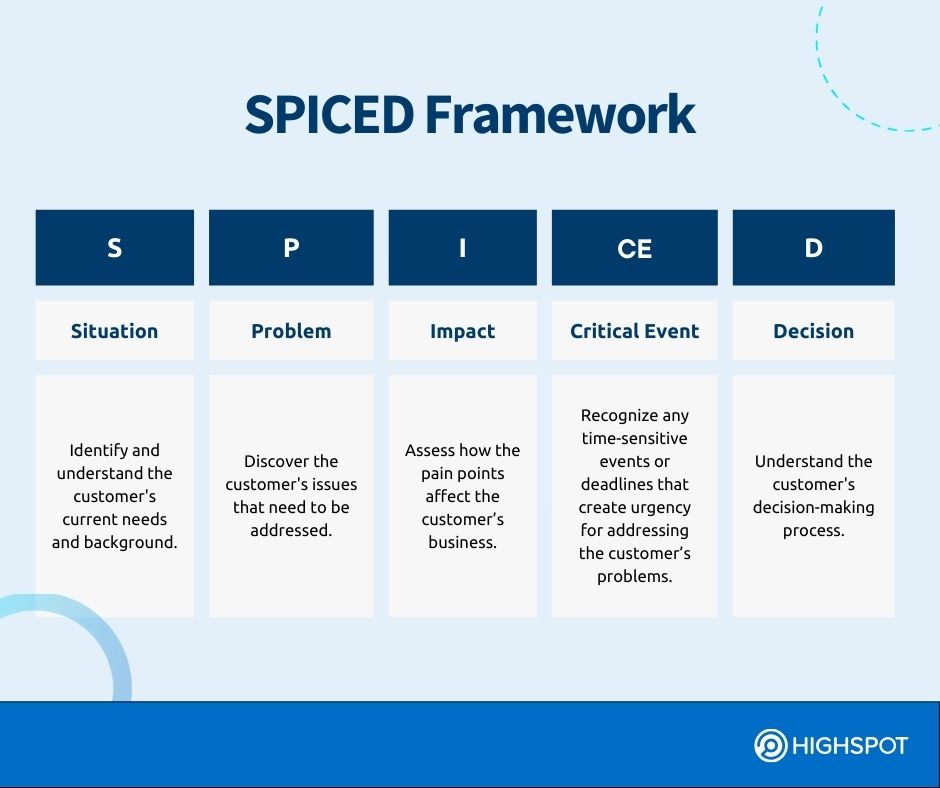The buying journey isn’t what it used to be. With so many options, ever-changing expectations, and people involved in decision-making, it’s no wonder why many sales teams often struggle to understand what their customers need. This challenge is even bigger in businesses where the real win isn’t just closing a deal but creating connections that keep your customers coming back.
This is where the SPICED framework comes into play. It unifies sales, marketing, and customer success teams by providing a clear, shared approach to understanding and addressing customer needs.
In this article, you’ll learn how to identify customer pain points, assess impacts, and navigate decision-making processes with sample questions and real-world examples.
Key Takeaways
- The SPICED framework helps sellers gather all the necessary details from prospects before recommending a solution.
- It’s useful for identifying prospects who are (and aren’t) the right fit for your product or service.
- It works best in complex sales environments.
What is the SPICED Framework?
Developed by Winning by Design, the SPICED framework is a five-step sales methodology that helps go-to-market (GTM) teams diagnose customer needs, recommend a compelling solution, and maintain strong, lasting relationships. SPICED stands for Situation, Pain, Impact, Critical Event, and Decision.
SPICED framework is particularly useful for needs-based or solution selling in the enterprise, software-as-a-service (SaaS), and recurring revenue business models. It helps sales reps understand their prospects’ backgrounds, foresee potential objections, and highlight the risks of not making a change. Ultimately, this framework helps prospects see the impact they need to make and motivates them to take action on their own.
Much like MEDDIC and BANT, the SPICED method empowers sellers to qualify inbound leads based on deal potential, buyer readiness, and the likelihood of closing. What makes it different is its emphasis on long-term customer success and retention.
Steps in the SPICED Sales Methodology

Each part of the SPICED framework serves as a key talking point for sellers during different stages of customer interaction to gather important information. It has consultative and provocative elements, where you ask questions to understand what the customer needs and encourage them to consider new perspectives. It also ensures that GTM teams cover all the crucial details needed for a successful sale.
Here is the step-by-step process of the SPICED framework:
Situation
Identify and understand the customer’s current situation. Gather information about their organisation, business demographics, and objectives to establish their fit into your ideal customer profile (ICP) and create a conversation baseline. You can find information on blogs, LinkedIn, product launches, customer feedback, and news releases.
Some discovery call questions you could ask to uncover their situation are:
- What’s a typical day like for you and your team?
- I saw that your company recently expanded. How is that going?
- What’s your main focus for this quarter in terms of business goals?
- Are you currently targeting any new markets or customer segments?
Start with broad questions to get the prospect talking about their current practices and how they operate. You should also attention to hints that indicate deeper issues. If the prospect begins expressing strong emotions, it’s a cue to steer the conversation toward exploring their pain points.
Pain
Discover the customer’s pain points. What issues or challenges hinder their success? Usually, these issues stem from unmet expectations or solutions that aren’t working well. Once you hear about these shortcomings, it’s a good opportunity to dive deeper. Understanding their pain helps align your solution to their needs.
Here are some questions you can ask:
- What’s the most significant bottleneck your team faces right now?
- Are there any specific processes that seem to slow things down for you?
- How is your team currently handling [specific challenge]?
- Have you received any feedback from customers about areas needing improvement?
If your prospects are downplaying their problems, ask follow-up questions to uncover the real cause of their pain. You should also pay attention to the prospect’s emotions. The stronger their emotional pain, the more receptive they’ll be to your solution.
Impact
Assess the impact of the pain points on the customer’s business. How do these challenges affect their operations, performance, and revenue?
This step emphasises the urgency and importance of finding a solution. The goal is to highlight the repercussions of the customer’s existing process and show the positive outcomes of addressing these challenges. This is also when you start building a strong case for why your solution is the right choice. Use data, case studies, and industry benchmarks to show how your product or service can make a real difference for their business.
Example impact questions are:
- Are these challenges impacting your revenue or market share?
- What would resolving this issue mean for your team’s productivity?
- Do you have any data on how these challenges are affecting customer satisfaction?
Critical Event
Identify critical events that drive the need for change. These events are usually a deadline or goal they’ve set and want to hit. They could be upcoming contract expirations, budget cycles, or regulatory changes. Recognising these events helps you position your solution as timely and relevant.
Some questions you could ask are:
- Is there a specific deadline by which you need this problem solved?
- Are there any contracts or vendor agreements expiring soon?
- How do upcoming budget reviews affect your current priorities?
- Are there any regulatory changes coming that could impact your operations?
Remember that the SPICED framework does not always strictly follow a sequence for impact and critical events. In some cases, prospects might already recognise their problem and have a few solutions in mind. You can identify these signs with active listening and uncover the full impact and critical events with follow-up questions.
More importantly, you shouldn’t force a deadline. Instead, focus on grasping your prospect’s sense of urgency.
Decision
During the decision stage, find out what it takes for your prospect to close the deal. This means learning about their decision-making process, the influencers, and their evaluation criteria.
Facilitate the decision-making process by addressing any concerns or questions they may have. Be ready to present your solution to different stakeholders If possible, develop connections with internal champions who can support your solution.
Example decision questions include:
- How do you typically finalise decisions like this with your team?
- Do you have any concerns I can help address to make this decision easier?
- What’s your timeline for implementing a new solution?
- Who are the other decision-makers, and who else is involved in evaluating solutions for your team?
Benefits of the SPICED Framework for Your Business
The SPICED framework’s diagnostic nature gets clients talking about their situation and highlights the risks of no change. It sparks movement to the next step. Putting the customer first makes them see more value in your offering and strengthens your relationship with them.
Here are the benefits that will ultimately impact overall revenue:
1. Create a consistent buying experience
The SPICED Framework aligns sales and revenue teams with a standardised approach, ensuring everyone speaks the same language and follows the same process. It also helps avoid misunderstandings and personal biases during lead qualification. This consistency leads to clearer communication and better collaboration.
2. Align GTM teams
Rolling out a new product is never easy. Sales, marketing, and product teams must sync to pinpoint customer needs and pain points. The SPICED framework can help uncover this information to help sellers create a unified, compelling narrative. It also aids in creating comprehensive buyer personas, ensuring GTM strategies resonate with the right target audiences.
3. Optimise sales productivity
The SPICED Framework streamlines the sales cycle by helping teams identify critical events and decision drivers early. This approach enables sales teams to prioritise high-value activities and focus on understanding customer needs and closing deals. Additionally, it improves lead generation by targeting the most promising prospects, ensuring that time and resources are spent on opportunities with the highest potential for successful conversions. This, in turn, improves sales productivity and forecasting.
4. Improve sales onboarding, training, and coaching
The structured nature of the SPICED Framework makes it an excellent tool for onboarding new sales team members and providing ongoing training and coaching. It offers a clear roadmap for understanding and engaging with clients, which helps new hires ramp up quickly and integrate with the team. Improving the skills of sales reps using the SPICED framework can drive 78% more annual recurring revenue (ARR).
SPICED Framework Application
Let’s explore a real-world application of the SPICED framework to selling AI solutions. We will explore sample discovery from each process step with a retailer seeking real-time customer insights.
- Situation: A retailer with 2,500 employees across six locations seeks to improve its customer insights capabilities. They currently use a mix of legacy systems and modern CRM platforms to manage their data.
- Pain: Their existing systems are cumbersome and require extensive manual data processing, creating workflow bottlenecks. The retailer’s marketing director spends hours each week manually compiling reports. Senior managers are concerned about the accuracy and timeliness of data insights, which are critical for decision-making in a competitive retail market.
- Impact: AI could automate data analysis and reduce operational costs. Real-time metrics would allow them to adapt more swiftly to customer needs, enhancing their competitive advantage. This capability could transform them from reactive to proactive.
- Critical Event: Leadership has set a deadline to implement improvements before their fiscal year-end meeting in Q4. The upcoming Q2 planning session coincides with their annual performance review, where they present growth strategies to key stakeholders. This is when the team will present solution options. They anticipate launching a new product line in Q4 and need predictive analytics.
- Decision: The team needs a solution that integrates with their existing CRM and is budget-friendly. The chief technology officer and head of data analytics are tasked with evaluating the software options, while final approval rests with the chief financial officer. The legal department will scrutinise the contract to ensure it aligns with company policies.
By applying the SPICED Framework, salespeople can seamlessly navigate the sales process, aligning their solution with the buyer’s needs and goals. This understanding leads to a successful and collaborative partnership.
Tools to Implement the SPICED Framework
Implementing the SPICED Framework requires the proper tools to gather and analyse information, facilitate communication, and ensure team integration. Here are some tools that can help:
- Customer relationship management (CRM) systems: CRMs like Salesforce manage and organise customer data. They allow sales reps to record and access detailed information about prospects, track interactions, and monitor sales progress, all of which are integral to the SPICED Framework.
- Sales enablement software: Tools like Highspot provide sales teams with the resources and insights needed to engage with prospects. They typically include a robust sales training platform, along with content management and analytics, enabling sales reps to deliver personalised and impactful presentations aligned with the SPICED Framework.
- Communication and collaboration tools: Platforms like Slack or Microsoft Teams facilitate real-time communication and collaboration among sales teams. These tools help sales reps share quickly, ensuring everyone is aligned and informed throughout the sales process.
Integrate SPICED Framework into Your Sales Process with Highspot
Incorporating the SPICED sales framework into your playbook can change how you engage with customers. You can develop long-term relationships and enhance every step of the customer journey. SPICED ensures that sales conversations are meaningful and effective by emphasising active listening and tailoring interactions to meet specific needs.
Highspot complements this approach by providing automation, templates, and tools that streamline the sales process. This allows teams to focus on what matters most: understanding and addressing customer needs. With Highspot, sales, marketing, and customer success teams can access resources that support a customer-centric sales strategy, helping them to create personalised, impactful experiences.
Request a Highspot demo today!




